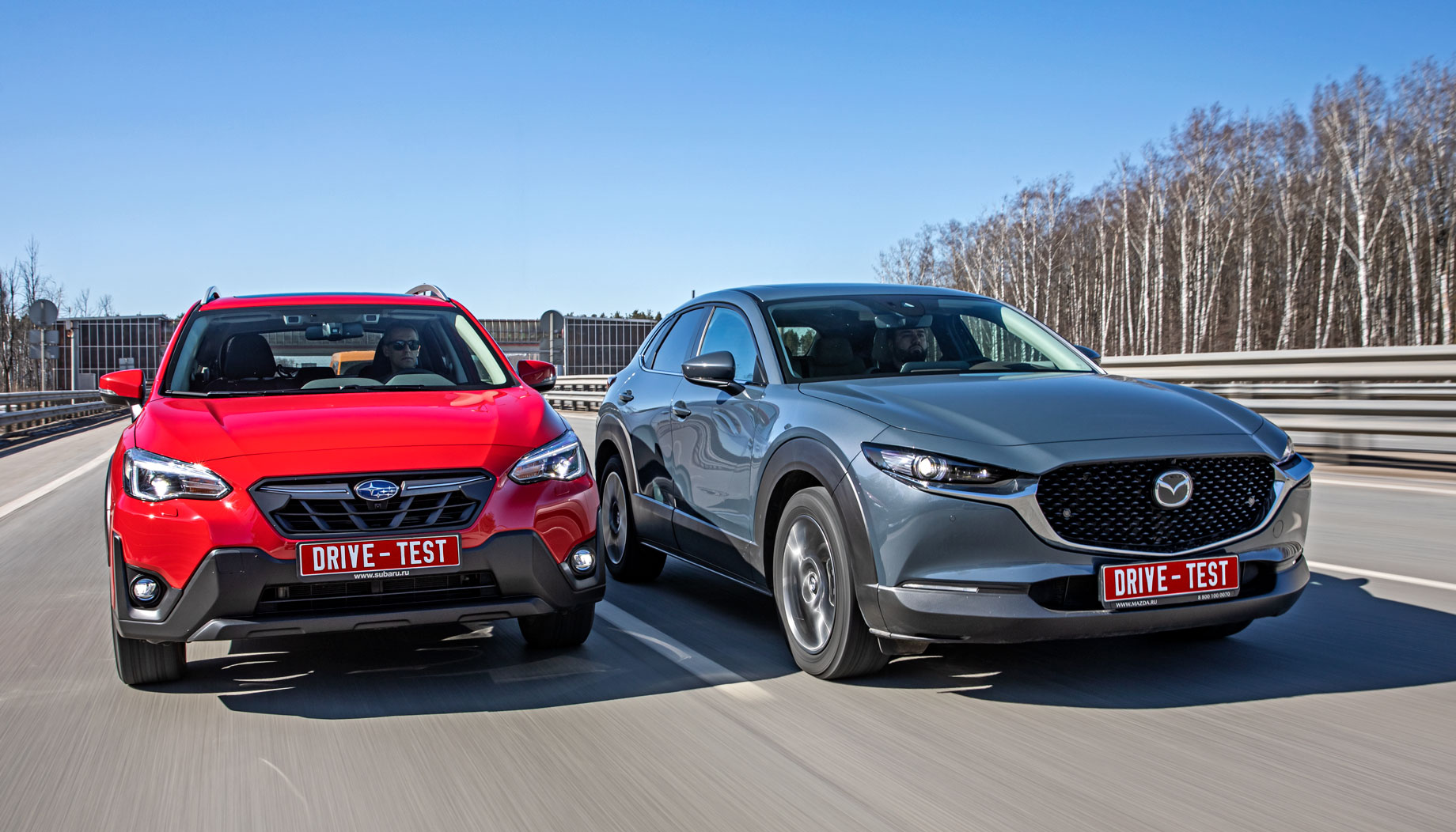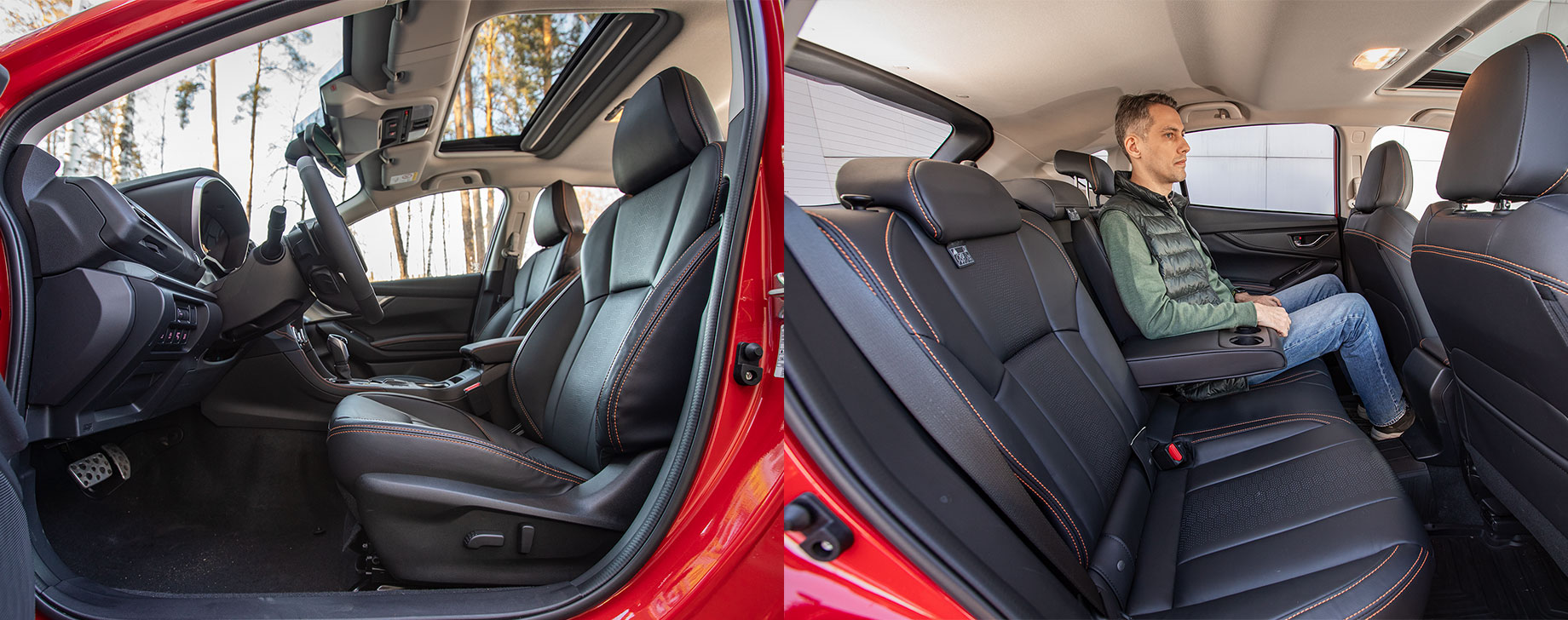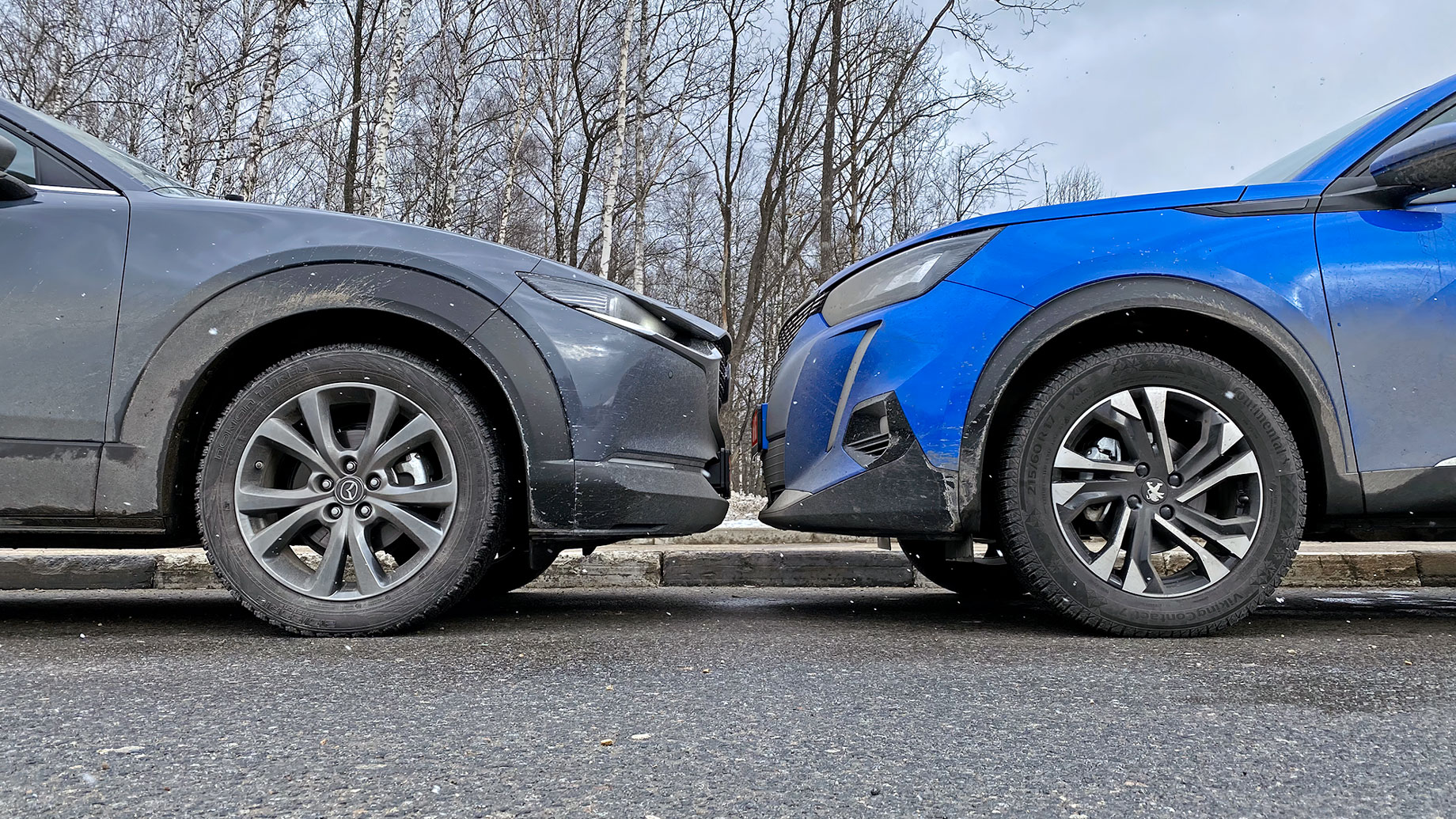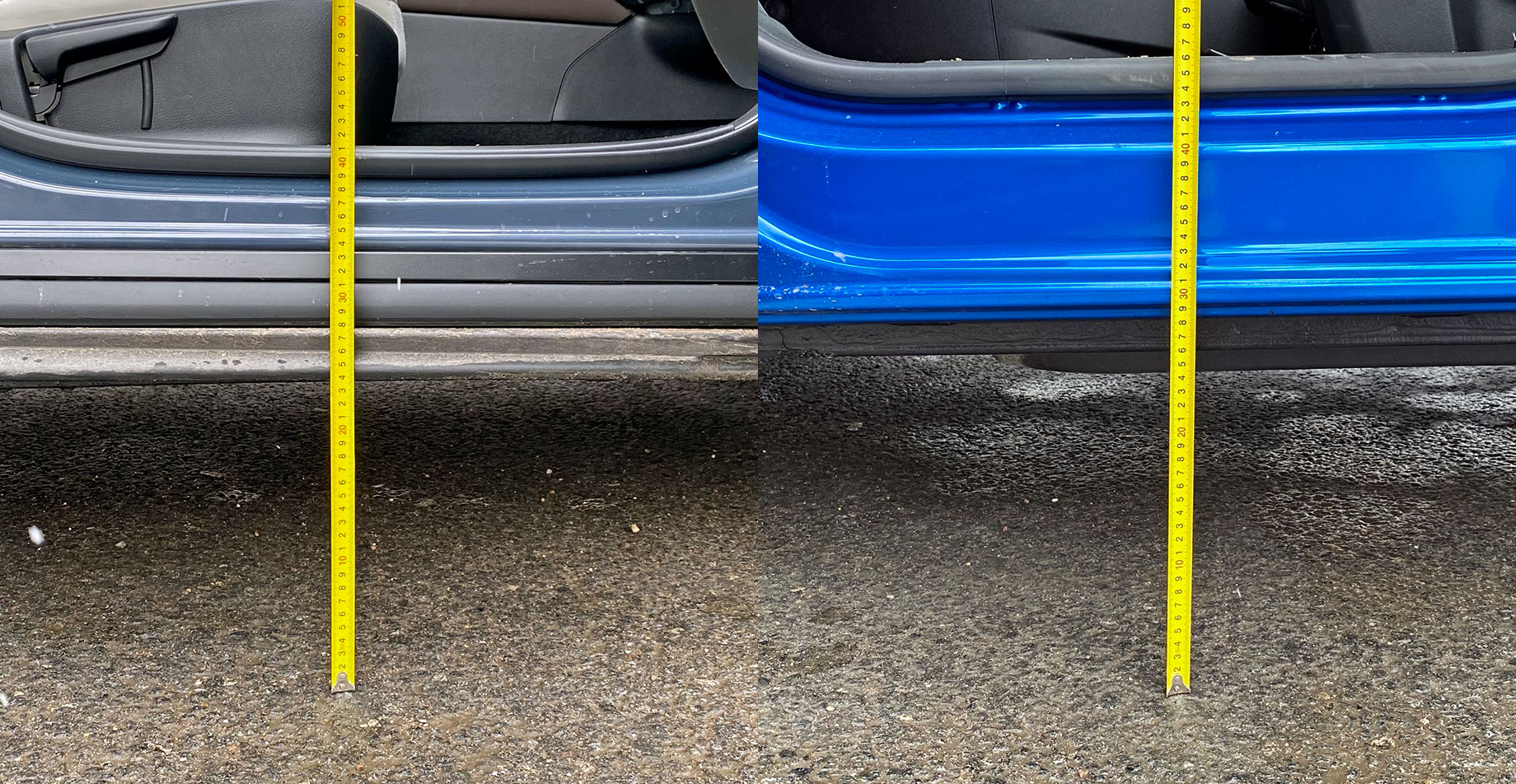Today’s test has several interesting features at once. Three cars are involved in it, but only Mazda CX-30 is familiar with the rest of the participants, so all the photos, for example, are paired.
“If you sit on the bank of the river long enough, you can see the corpse of your enemy floating along it.” Having not particularly proved themselves on the market, Peugeot and Subaru saw off the excellently started CX-30. Mazda demand is such that the main markets take in all the reserves, leaving nothing for the secondary ones.

But at first glance, there is nothing outstanding in Mazda. Whichever way you look, it’s a grey blur. Whether it is against the backdrop of extravagant Peugeot or next to the XV, torn by design contradictions. But it is these two who help to understand how we yearned for conciseness. The moderate detailing and calm plastics of the CX-30 carry no metadata about either the date of manufacture or the keeping period.
Peugeot has a completely different approach: the 2008 model is a up-to-the-minute car, designed to be at the height of fashion, to make today’s day highly charged and more emotional. The European market proves that there is a demand for breaking stereotypes. Indeed, when you first find yourself inside of the 2008 model, you experience a shock bordering on helplessness, it seems that you can’t rely on previous automobile experience here.
While the interiors of the CX-30 and XV are largely bare of novelty, the Peugeot is eerily fresh. It allows you to sit like in a passenger car with your legs outstretched, although the seat is set at the same height as in Mazda, with its more traditional posture for the segment. Psychological effort in 2008 is required even at the level of steering adjustment. Few people are intuitively ready to put it almost on their knees, otherwise the dashboard located above the steering wheel overlaps the rim.
As a result, you climb into a crossover, climbing over a high and wide sill, and you sit as if in some kind of Caterham. Geometrically, it’s just great, no doubt. Only if the open Caterham provides excellent visibility in all directions, here a B-pillar looms at the temple, making it difficult to look sideways, and a wide zone is added to the thick front ones, where the wipers do not reach.

The position of the dashboard and the shape of the steering wheel are the least controversial ergonomic solutions. I would include climate control through a touch screen, which is usually occupied by broadcasting from a smartphone, as a conflict. And the left hand, for example, has to be squeezed between the closely spaced understeering shift of the turn signals and the cruise control. Between touching the starter button and starting the engine, there is sometimes such a long pause that you involuntarily press until it starts to work.
Geometrically the seating position in the Subaru is the least sporty. The steering wheel can not be pushed so close to you that you do not reach out while sitting on the pedals. While Mazda is taking a very European approach to interior layout, Subaru still sticks to the specific principle of distributing information between three displays at different heights. The interface is a budget mix of touch and button controls…

Peugeot is the most compact here and already more than 440 lbs lighter than Mazda, but falls short of power and speed to the six-speed automatic gearshift of Aisin. At a parallel start, to pull away from the CX-30 with a two-liter aspirated engine, you need to land an extra person out from the 2008 and drain half the tank. When seated in pairs and fully refueled, crossovers accelerate head to head. You don’t expect much agility from XV, but Subaru doesn’t lag behind Mazda, despite a small makeweight and a variator assisting the opposed “fours”.
With comparable uttermost capabilities, the nuances of traction control come to the fore. Everything here isn’t without sin. Automatic gearshift of Peugeot maintains an economical, but the most uncomfortable mode for passengers, in which a noisy and vibration-loaded three-cylinder engine is forced to rumble at low speeds. It is hard for the 2008 gearbox to do well with downshifts. Moreover, I haven’t seen such obvious mistakes in the choice of gear for a long time. In response to a kickdown from 49,7 miles/h, Aisin goes down one step, tries to take it out, and only then pokes the lower one, not finding enough traction.
The Mazda resembles a little bear, whose stomach is constantly growling. The womb voice is about it. Extraneous sounds are also heard: either a transmission whistle, or a generator one. Well-known to us aspirated 2.0 is an independent character here. It willingly responds to the gas, but the six-speed automatic gearshift deadens the reaction. The torque converter lacks blocking rigidity: at a constant throttle position, the speed floats, the motor howls. In manual mode, the CX-30, when going down, seems to make nice throttle blips, but the engine slows down a bit.

Subaru engineers have overcomplicated too. The initial response to the fuel supply when starting off is so sharp that it requires increased attention when driving in traffic jams. But this acceleration response is deceptive. If you fix the pedal in a small angle, the development of acceleration doesn’t continue according to the same logic. To accelerate, you need to push the accelerator deeper. Coming into traffic from a secondary road, the XV requires some very daring gas work. The need to adapt to the changeable settings of the power unit recalls Marshak’s line: “The ass is astride on the back of the old”.
When trying to accelerate intensively, the variator quickly drives the engine to the maximum torque and keeps it in the range of four to five thousand. The opponent’s sound, though not devoid of pleasantness, but at such a frequency there is too much of it. It has already solos mostly against the background of muffled road noise. If you interrupt the acceleration with a short speed drop and try to get on the gas again, the transmission pause hangs as a reminder of the unusual design of the variator, where the torque converter is designed to soften sign-changing loads.
Subaru is the most comfortable here. Compared to competitors, the suspension seems strong, and the resonant characteristics of the body, which isn’t too rigid, are well matched. For example, what happens to a denser Peugeot at the joints and sharp bumps is that it itches with a low frequency all over the body. Although the chassis itself provides a good ride, and it has enough power even for large potholes. But rare blows during the rebound stroke are unpleasantly amplified by the body. Therefore, on a bad road you go calmer than the suspension really allows, while the Subaru speed is limited only by the instinct of self-preservation. The main thing in the city is to remember that speed control bumps are not laid down for beauty.
On a bad piece of road, Mazda makes its way more carefully than others. It doesn’t hold the blow and suffers, without holding back complaints. But on decent asphalt, the chassis doesn’t rattle, and the overall level of comfort is pulled up to the bar of the 2008. Mazda wobbles less, but collects more small things. The response to joints is also higher, but without unpleasant resonance. If you look at a simple sound level meter in an Apple watch, its test value is about two decibels higher in Mazda. Tires are dominant in both cars, but the CX-30 lacks the overt aerodynamics that Peugeot develops after 68,37 miles/h. By 80,8 miles/h the difference almost disappears.

Even from the photographs, you can see that the 2008 provides more space for rear passengers than the CX-30; let a person of my height 6’1 sit in the front. So for such a completely family car, Peugeot brings a surprising amount of speed into the turn and keeps it on the arc, maintaining a very good balance of turnability. However, what else is left for it when the gas pedal is glued to the floor in order to keep up with the pace of Mazda, not giving the automatic gearbox a chance to go for a smoke break.
The behavior of Peugeot has a circus element. It is difficult to accurately set the trajectory with a light steering wheel. Everything has to be done at random, laying the need for correction. The “French” rolls more strongly, in a turn with difficult terrain begins to “dance” and “sway”, it itself is frightened of this and turns to the non-switchable stabilization system. Viking Contact 7, one of my favorite tires, indicates the limit of traction with a squeak, but the nose doesn’t plow, all four wheels begin to slide, and if there is a sudden perception of demolition, the electronics delicately intervene.
Mazda’s steering wheel is better balanced, it listens to him more lively, on the contrary to the Hakkapeliitta R3. Willingly stands on an arc and draws it as a whole, the rear wheels go exactly behind the front ones. The response to a change in thrust is clearer, therefore, the redistribution of mass in dynamics here is an effective tool for controlling the trajectory. Excessive sensitivity to the slope of the road bed and the associated explicit forceful steering correction are of the downsides.
Peugeot also pulls the steering wheel: it dances in hands both under the influence of the camber and under traction. But it’s hard to pull out Mazda’s grippy steering wheel, but the spokes of 2008 are so wide that you don’t clasp them, but press them with your fingers to your palms, like an expander. The load on the wrists is high, and the control is unreliable…
Subaru dynamics are the least ambitious. By getting the XV guts ripped out, you can find that the handling balance is good, and you can stay at Mazda’s pace if you want. But the whole nature of the “Japanese” resists pressure. It’s even difficult for me to drive the Subaru close to another car, as the shooting requires, because of the constantly panicking EyeSight system. It’s not limited to a piercing squeak, cutting off the fuel supply.

Video cameras are the staff of life here: even adaptive cruise control works without radar support, only based on optical data. But cameras, even big ones like Subaru’s, don’t work well in poor visibility. However, the mere presence of a radar is also not a guarantee of success, as Mazda’s cruise control shows. Sometimes it slows down so sharply, as if someone for the first time in his life pulls out with his left foot in panic. It can be scary for those who ride behind, especially if they don’t keep their distance. It is unsafe to use such an inadequate system in the city. Only Peugeot has a speed limiter ideal for a metropolis…
There is no off-road, as it is, in our program, and even a front-wheel drive Peugeot climbs onto the favorite snowy slope, demonstrating good geometric cross-country ability along the way. The stabilization system zealously maintains directional stability even when traction control is turned off, but doesn’t interfere with the assault on the hillside.
Mazda doesn’t provide any off-road programs at all. And if you stop on a slippery slope and try to start off again, it’s in no hurry to connect the four-wheel drive, skidding the front wheels for a long time. However, Peugeot cannot interrupt the climbing at all — you have to roll back and take the hillside in motion. By the way, only the 2008 is equipped with a downhill assist control, which gently slows down the wheels.
While the XV received an additional Deep Snow/Mud off-road program during the latest update, it is the non-switchable stabilization system that turns out to be a weak point. Too zealously, it extinguishes skidding where it is vital. And the CVT doesn’t want to raise the speed above three thousand in any way, in order to give the driver a chance to mechanically overcome the stubborn electronics. Too smart for its own good…

Despite the fact that historically it is easier for me to associate myself with Mazda, in each of today’s duets I’d prefer its rival. They are brighter, more distinctive. Peugeot surprises with unexpected freedom in extreme modes. The chassis is capable of pushing everything out of the turbo engine, obscene in transient conditions and capable of creating only in large strokes. Subaru dazzles with a combination of unfussy design, budget manufacturing solutions and the feeling of a quality thing on the go. Although with this traction control setting, all-wheel drive turns into a burden.
Mazda seems as if the result of their division into each other. It’s a sort of arithmetic mean. Not too bold, not too boring. Choosing a Mazda requires the least personal effort from the buyer. And leaving the market, it gives us the opportunity to pay attention to other, not the most obvious options, forcing the potential owner to enter into an internal dialogue with himself. Moreover, the positions of Peugeot have recently become a little stronger with the appearance of a 150-horsepower modification with an eight-speed automatic gearbox.
Of course, the 2008 remains front-wheel drive, but the city dweller’s lack of drive torque on the rear wheels is partly compensated by 215 millimeters of ground clearance under the steel protection of the power unit — this is even a centimeter more than Subaru. I deliberately rolled out in a new, no less grumpy version of the GT at rush hour, and crossed out literally all questions about traction control. Peugeot’s biggest problem is the brakes. Although they are increased in accordance with the increased power, the drive categorically lacks information content. It seems as if there is some kind of cottonwool under your feet.

In addition, the Japanese aren’t yet in a hurry to include XV in the new five-year warranty program. Peugeot sellers recommend looking for suitable options on the official website, where the list of cars on the way to your country and in stock is updated almost daily. Say, so you can even snatch something without special extras.
The version with a capacity of 150 horse forces is $1,565 more expensive than the 130-forceful Allure, as in the test, which costs $18,135. That is, even according to the price list, it will cost $16,600. But even such a 2008 turns out to be much more affordable than the XV, recommended prices of which starts from $23,600. It is nice that in both cases the purchase is primarily an act of preference for the manufacturer, not tightly tied to the consumer properties of the car. I’m still more for emotional purchases.
This is a translation. You can read the original here: https://www.drive.ru/test-drive/mazda/peugeot/subaru/608c52e1722dd36d6cc05b2c.html

Published April 07, 2022 • 16m to read



